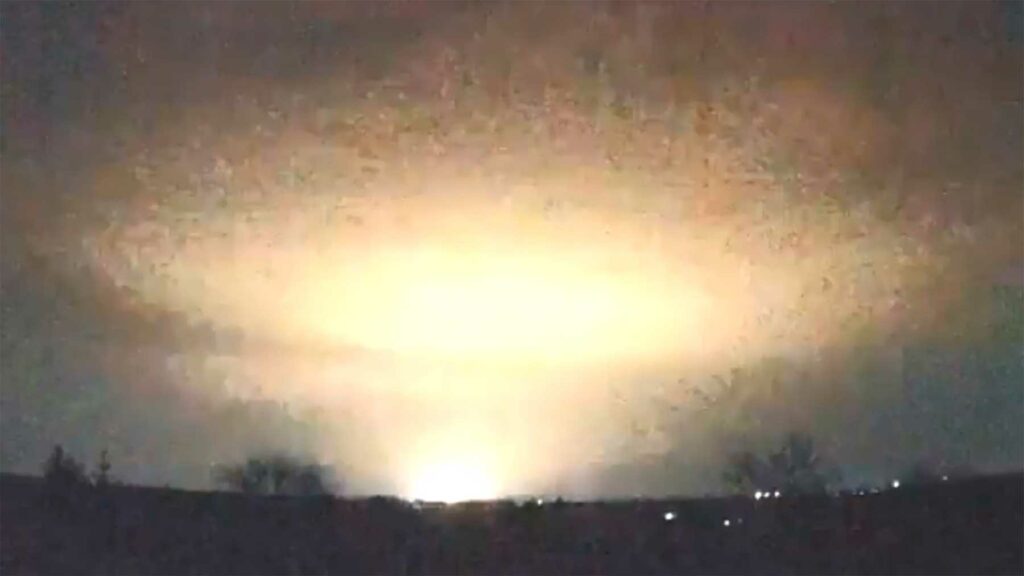
The Oreshnik missile, based on the RS-26 Rubezh, was used by Russia to strike Ukraine, revealing a new intermediate-range ballistic missile.
On November 21, 2024, Russia launched an attack on Ukraine using a novel intermediate-range ballistic missile named Oreshnik. The missile is derived from the RS-26 Rubezh, an intercontinental ballistic missile whose development was suspended in 2018. The Oreshnik reaches a top speed of Mach 10 and is equipped with non-nuclear hypersonic technologies. Its use marks an escalation in the Russian-Ukrainian conflict and raises questions about Russian military capabilities, the effectiveness of existing missile defense systems and strategic implications for international security.
Background to the Oreshnik missile attack
On November 21, 2024, Russian President Vladimir Putin announced that the Russian armed forces had used a new intermediate-range ballistic missile, the Oreshnik, in an attack on the Ukrainian city of Dnipro. This action follows Ukraine’s use of weapons supplied by the United States and the United Kingdom. According to Putin, the missile was tested under real combat conditions to strike a facility of the Ukrainian military-industrial complex.
The Ukrainian authorities initially thought it was an intercontinental ballistic missile, but the Pentagon confirmed that it was an intermediate-range missile. Images of the attack show six warheads descending on the target, resulting in several significant impacts. This attack represents an intensification of the conflict and underlines Russia’s determination to demonstrate its advanced military capabilities.
In a televised statement, Putin asserted that the Oreshnik is equipped with non-nuclear hypersonic technologies and reaches a top speed of Mach 10 (around 12,250 km/h). He also warned that future targets would be determined according to threats to Russia’s security, while assuring that warnings would be given to civilians to evacuate high-risk areas.
Russia’s use of the Oreshnik missile raises international concerns about conflict escalation and regional stability. It also raises questions about the ability of current defense systems to intercept hypersonic missiles.

Technical details of the Oreshnik missile and its genesis
The Oreshnik missile is an intermediate-range ballistic missile (IRBM) derived from the RS-26 Rubezh. The RS-26 is itself a smaller version of the RS-24 Yars, an intercontinental ballistic missile in service in Russia. Development of the RS-26 was suspended in 2018, but it seems that Russia has continued work on the Oreshnik.
The Oreshnik reaches a maximum speed of Mach 10, which classifies it as a hypersonic missile. At this speed, it is extremely difficult for current missile defense systems to intercept it. The missile is equipped with non-nuclear hypersonic technologies, but it is not specified whether it uses maneuverable re-entry vehicles or hypersonic gliders like the Avangard.
Fragments of the missile recovered after the attack show similarities with components of the Bulava submarine-launched ballistic missile, suggesting a degree of standardization in the production of Russian strategic missiles. This approach could facilitate the mass production and maintenance of these weapons.
The exact range of the Oreshnik has not been disclosed, but as an IRBM, it is between 3,000 and 5,500 kilometers, covering much of Europe and Asia. The missile is probably capable of carrying multiple warheads, increasing its effectiveness against multiple or heavily defended targets.
RS-26 Rubezh: background and development
The RS-26 Rubezh is a ballistic missile initially classified as intercontinental, but whose actual range places it more in the intermediate-range category. Its development began in the early 2010s, with tests carried out until 2018. The RS-26 is designed to be mobile, launched from ground vehicles, increasing its survivability in the event of conflict.
The missile is equipped with MIRVs (multiple independently targetable re-entry vehicles), enabling it to strike several targets simultaneously. This feature enhances its deterrent capability and complicates the opponent’s missile defense. The RS-26 was associated with the development of the Avangard hypersonic glider, capable of maneuvering at extremely high speeds to evade interception systems.
The program’s suspension in 2018 was officially due to budgetary constraints, but some analysts believe it was linked to strategic and diplomatic considerations, notably concerning the Intermediate-Range Nuclear Forces (INF) Treaty. The reappearance of the RS-26 in the form of the Oreshnik suggests that Russia has continued its research in secret.
The RS-26 represents an important step in the modernization of Russia’s strategic forces, aimed at overcoming the missile defense systems deployed by the USA and its allies. Its adaptation as an Oreshnik testifies to Russia’s commitment to developing advanced weapons to maintain a strategic advantage.
Oreshnik missile features: range, speed, payload
The Oreshnik missile is classified as an intermediate-range ballistic missile with an estimated range of between 3,000 and 5,500 km. This range enables Russia to strike targets far beyond its borders, potentially covering all of Western Europe.
With a maximum speed of Mach 10, the Oreshnik falls into the category of hypersonic weapons. This speed makes interception extremely difficult for current missile defense systems, which are generally designed to intercept targets at lower speeds.
The Oreshnik’s payload is likely to consist of multiple warheads, thanks to the MIRV technology inherited from the RS-26. It could carry both conventional and nuclear warheads, although its stated use is non-nuclear. The ability to carry multiple warheads increases the missile’s effectiveness against dispersed or heavily defended targets.
It is possible that the Oreshnik will use maneuverable re-entry vehicles or hypersonic gliders, which would further complicate its interception. These technologies enable the missile to alter its trajectory in flight, thus avoiding areas covered by missile defenses.
Strategic implications of using the Oreshnik
The introduction of the Oreshnik into the conflict has significant strategic implications. On the one hand, it demonstrates Russia’s ability to deploy advanced weapons in response to Western military assistance to Ukraine. On the other, it highlights the limitations of current missile defense systems in the face of hypersonic threats.
The use of the Oreshnik could prompt NATO countries to accelerate the development of new defense technologies, particularly against hypersonic missiles. This could lead to an arms race in the region, increasing tensions and the risk of direct confrontation.
Putin’s statements that future targets will be chosen on the basis of threats to Russian security suggest a strategy of deterrence. By demonstrating its ability to strike quickly and effectively at strategic targets, Russia is probably seeking to dissuade Western countries from stepping up their support for Ukraine.
This situation also poses challenges for international arms control treaties. The use of missiles like the Oreshnik could be seen as a violation of the spirit, if not the letter, of agreements aimed at limiting the proliferation of long-range weapons and hypersonic technologies.

International reactions and implications for global security
International reactions to the use of the Oreshnik were swift. The United States confirmed the launch and indicated that it had been previously informed via nuclear risk reduction channels. This shows a certain willingness on Russia’s part to keep lines of communication open to avoid uncontrolled escalation.
The Pentagon downplayed the strategic impact of the Oreshnik, claiming that it would not change the dynamics of the conflict in Ukraine. However, the difficulty of intercepting hypersonic missiles remains a major concern for the international community.
European countries, particularly those within range of Russian IRBMs, are expressing concern about their vulnerability to these new weapons. This could lead to a reassessment of defense strategies and an increase in military spending to develop effective countermeasures.
Diplomatically, the use of the Oreshnik complicates efforts to find a peaceful solution to the conflict. It can be seen as a show of force designed to dissuade Ukraine’s allies from providing further assistance, while strengthening Russia’s position in future negotiations.
Future prospects
Russia’s use of the Oreshnik missile marks a significant escalation in the conflict with Ukraine and raises crucial questions about international security. It highlights the challenges posed by hypersonic weapons and the need for nations to develop appropriate defense systems.
Western countries will probably have to step up their efforts to support Ukraine, while seeking solutions to ease tensions with Russia. This could include enhanced diplomatic negotiations, the reopening of arms control talks and the implementation of mutual confidence-building measures.
The international community faces a difficult choice: how to respond effectively to the introduction of new advanced weapons without provoking further escalation? The coming months will be decisive for the future of the conflict and global stability.
War Wings Daily is an independant magazine.